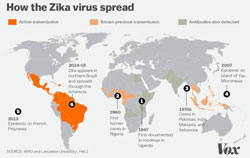As explained by the Pan American Health Organization, the Zika virus is an infection that is transmitted through the bite of an infected mosquito of the Aedes genus. This virus usually causes mild fever, exanthema (skin rash), conjunctivitis, and muscle pain.
Although the first isolated case was in the Zika forest of Uganda in 1947 with minor outbreaks in the Asian regions, the Zika virus soon became a widespread epidemic that affected individuals both asymptomatically and symptomatically. Nearly one in five people infected show symptoms that were very similar to those of the dengue or chikungunya.
However, studies show that 80 percent of infected individuals do not feel ill or show any symptoms. According to an article in The New York Times, women who live in or have visited infected areas during the beginning of their pregnancy may have experienced birth defects with their newborn such as microcephaly.
Microcephaly is a medical condition where the fetus’s head is abnormally smaller than it should be and is often associated with incomplete brain development. If an infected mosquito bites a woman during her pregnancy, the infection could make its way into the amniotic fluid that aids in the nourishment and well-being of the fetus which could ultimately make the fetus more susceptible to birth defects.
At first, microcephaly was not seen as a symptom for women who were infected while pregnant. Health officials often counted microcephaly as a symptom for other possible illness that could cause this birth defect. Some of these illnesses include: rubella (measles), poisoning of the fetus through alcohol intake, gene mutations, severe maternal malnutrition (common in impoverished regions), etc.
The Centers for Disease Control (CDC) was asked a series of questions about any existing tests that could determine whether an individual is indeed infected with Zika. Tests for the virus only work during the first week after infection. Tests for antibodies can be done, but they may yield false positives if the woman has had dengue, yellow fever, or has received the yellow fever vaccine.
Pregnant women who have been to infected regions should have an ultrasound scan to see if their fetus is developing microcephaly or calcification of the skull. However, an ultrasound can usually only detect microcephaly after the second trimester. Amniocentesis is also offered for fetuses who are at risk. A positive RT-PCR (reverse transcriptase-polymerase chain reaction) result after testing the amniotic fluid could be indicative of an intrauterine infection.
Health care professionals can then suggest the level of neonatal care needed after delivery and safety precautions that can be taken throughout the rest of the pregnancy which can ultimately aid in the health of both the mother and the fetus.
“I think preventative medicine is extremely important in the health care industry as it cuts higher emergency medicine costs later on. Rapidly spreading viral infections are often difficult to contain, but immediate action to curb the spread is essential to mitigate the risk, reduce costs, and allows for more time to research and target the infection,” said Sachin Parikh, sophomore biology student.
From previously reported cases, the Zika virus was thought to be spread only by the infected mostquitoes of the Aedes genus. However, recent reports by PIX11, broke the news of the first case in which the viral infection was sexually transmitted here in the United States. The CDC predicted the likelihood of the disease appearing in the U.S. by explaining that the likelihood of viral introduction and local spread in the U.S. has increased. With new cases being reported in Puerto Rico and the U.S. Virgin Islands, the number of U.S. travelers is expected to increase throughout time.
Since health officials often associated the Zika virus to other related illnesses, the virus hasn’t grabbed the attention of the infectious diseases specialists until its recent outbreak. “Through an organic chemistry perspective, there should be a scientific view here that should be applied and doesn’t happen well in the popular press,” said Dr. William Schreiver, Chair of the Chemistry and Physics Department.
“I feel that effort should be made where the public health consequences show that the problem is serious. There are possibly more significantly dangerous diseases and other things that don’t fall in the infectious disease category that represent a far greater threat to the individual. However, it does pose a great threat to women who are pregnant. Research efforts and the funding for research is finite and it has to be done by looking at the overall public health consequences. There is something going on now that seems to be spreading this disease much further that wasn’t contributing to its widespread in the past. These are very difficult questions and decisions that are not easily answered.
Unfortunately, the popular press will continue to inform the population of this disease which will instill fear in the infected population and their adjacent countries. These things need to be studied, but we have to look at public health issues as a whole.”
Public health issues are extremely difficult to tackle. Just when researchers have found the solution to a viral, parasitic, or bacterial infection, they are reminded that there are many deadly illnesses in the world that have yet to have set treatment or a vaccine. Some diseases may even grow resistant to treatment overtime such.
However, there are ways to help prevent individuals from contracting certain diseases while visiting other countries. If you’re traveling to a country that faces public health issues, ask your doctor for any recommended vaccinations you should receive before your travels or check the CDC website for more information.
IMAGE TAKEN from http://www.vox.com




